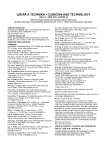-
Články
- Časopisy
- Kurzy
- Témy
- Kongresy
- Videa
- Podcasty
ANTIBACTERIAL ACTIVITY OF TITANIUM DIOXIDE AND AG-INCORPORATED DLC THIN FILMS
Titanium dioxide (TiO2) and Ag-incorporated diamond-like carbon (DLC) films were prepared on different substrates. The films were prepared by pulsed laser deposition (PLD). TiO2 and Ag were selected due to their potential values as biomaterials. Silver is effective against a wide range of spectrum including Gram-negative and Gram-positive bacteria and yeast. TiO2 and Ag-incorporated DLC thin films are suitable candidates for application on biomedical devices and implants due to their biocompatibility, chemical inertness, and mechanical properties. Thin films are widely used in coronary artery stents, dental implants, heart valves and other vascular devices. The microstructure and antibacterial properties of TiO2 and silver-doped diamond-like carbon (DLC) films have been investigated. The films structural quality was evaluated using SEM microscopy, AFM microscopy and Raman spectroscopy. The antibacterial activity was determined using Gram-negative bacteria Escherichia coli and Gram-positive bacteria Bacillus subtilis. Our results demonstrate that the TiO2, nitrogen doped titanium oxides TON and Ag-incorporated DLC films are potentially useful as biomedical materials having good antibacterial properties.
Keywords:
thin films, pulsed laser deposition, antibacterial properties, Gram-negative bacteria, Gram-positive bacteria, implants
Autoři: Veronika Vymětalová 1; Miroslav Jelínek 1; Petr Písařík 1; Jan Mikšovský 1; Jan Remsa 1; Veronika Řasová 1
Působiště autorů: Czech Technical University in Prague, Faculty of Biomedical Engineering, Kladno, Czech Republic 1
Vyšlo v časopise: Lékař a technika - Clinician and Technology No. 3, 2016, 46, 65-68
Kategorie: Původní práce
Souhrn
Titanium dioxide (TiO2) and Ag-incorporated diamond-like carbon (DLC) films were prepared on different substrates. The films were prepared by pulsed laser deposition (PLD). TiO2 and Ag were selected due to their potential values as biomaterials. Silver is effective against a wide range of spectrum including Gram-negative and Gram-positive bacteria and yeast. TiO2 and Ag-incorporated DLC thin films are suitable candidates for application on biomedical devices and implants due to their biocompatibility, chemical inertness, and mechanical properties. Thin films are widely used in coronary artery stents, dental implants, heart valves and other vascular devices. The microstructure and antibacterial properties of TiO2 and silver-doped diamond-like carbon (DLC) films have been investigated. The films structural quality was evaluated using SEM microscopy, AFM microscopy and Raman spectroscopy. The antibacterial activity was determined using Gram-negative bacteria Escherichia coli and Gram-positive bacteria Bacillus subtilis. Our results demonstrate that the TiO2, nitrogen doped titanium oxides TON and Ag-incorporated DLC films are potentially useful as biomedical materials having good antibacterial properties.
Keywords:
thin films, pulsed laser deposition, antibacterial properties, Gram-negative bacteria, Gram-positive bacteria, implants
Zdroje
[1] Kääriäinen, M.L.; Kääriäinen, T.O.; Cameron, D.C.: Titanium dioxide thin films, their structure and its effect on their photoactivity and photocatalytic properties. Thin Solid Films, 2009, vol. 517, no. 24, p. 6666–6670.
[2] Xu, N.; Shi, Z.; Fan, Y.; Dong, J.; Shi, J.; Hu, M.Z.-C.: Effects of particle size of TiO2 on photocatalytic degradation of methylene blue in aqueous suspensions. Industrial and Engineering Chemistry Research, 1999, vol. 38, no. 2, p. 373–379.
[3] Anpo, M.: Preparation, characterization, and reactivities of highly functional titanium oxide-based photocatalysts able to operate under UV-visible light irradiation: Approaches in realizing high efficiency in the use of visible light. Bulletin of the Chemical Society of Japan, 2004, vol. 77, no. 8, p. 1427–1442.
[4] Michael A. Henderson: A surface science perspective on TiO2 photocatalysis. Surface Science Reports, 2011, vol. 66, no. 6–7, p. 185–297.
[5] Lin, H.; Xu, Z.; Wang, X.; Long, J.; Su, W.; Fu, X.; Lin, Q.: Photocatalytic and antibacterial properties of medical-grade PVC material coated with TiO2 film. J. Biomed. Mater. Res. B. Appl. Biomater. 2008, vol. 87, no. 2, p. 425–431.
[6] Foster, H.A.; Ditta, I.B.; Varghese, S.; Steele, A.: Photocatalytic disinfection using titanium dioxide: spectrum and mechanism of antimicrobial activity. Appl. Microbiol. Biotechnol., 2011, vol. 90, no. 6, p.1847–1868.
[7] Kurtoglu, M. E.; Longenbach, T.; Gogotsi, Y.: Preventing Sodium Poisoning of Photocatalytic TiO2 Films on Glass by Metal Doping. International Journal of Applied Glass Science, 2011, vol. 2, p. 108–116.
[8] Kwok, S.C.H.; Zhang, W.; Wan, G.J.; McKenzie, D.R.; Bilek, M. M.; Chu, Paul K.: Hemocompatibility and antibacterial properties of silver doped diamond-like carbon prepared by pulsed filtered cathodic vacuum arc depositin. Diamond & Related Materials, 2007, vol. 16, p. 1353–1360.
[9] Liau, S. Y.; Read, D. C.; Pugh, W. J.; Furr, J. R.; Russell, A. D.: Interaction of silver nitrate with readily identifiable groups: relationship to the antibacterial action of silver ions. Lett. Appl. Microbiol., 1997, vol. 25, p. 279–283.
[10] Russell, A. D.; Hugo, W. B.: Antimicrobial activity and action of silver. Prog. Med. Chem. 1994, vol. 31 : 351–370.
[11] Remsa J.; Mikšovský J.; Jelínek M.: PLD and RF discharge combination used for preparation of photocatalytic TiO2 layers, Applied Surface Science, 2012, vol. 258, p. 9333–9336.
[12] Remsa J.; Jelínek M.; Kocourek T.; Mikšovský J.; Studnička V. et al.: Physical and photocatalytic properties of laser fabricated crystalline TiO2 at low temperatures. Journal of Optoelectronics and Advanced Materials 2010, vol. 12, no. 3, p. 754–757.
Štítky
Biomedicína
Článok vyšiel v časopiseLékař a technika

2016 Číslo 3
Najčítanejšie v tomto čísle- VYUŽITIE MULTIPLEXNEJ RT PCR V DIAGNOSTIKE MIKROBIONÁLNYCH PATOGÉNOV
- ANTIBACTERIAL ACTIVITY OF TITANIUM DIOXIDE AND AG-INCORPORATED DLC THIN FILMS
- RESPIRATORY ARRHYTHMIA AS AN ENCOURAGEMENT OF INAPPROPRIATE ICD THERAPY
Prihlásenie#ADS_BOTTOM_SCRIPTS#Zabudnuté hesloZadajte e-mailovú adresu, s ktorou ste vytvárali účet. Budú Vám na ňu zasielané informácie k nastaveniu nového hesla.
- Časopisy


